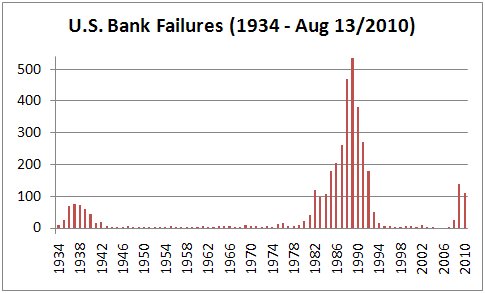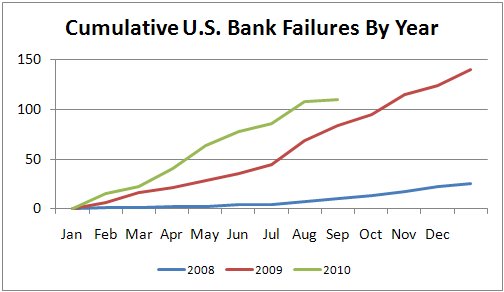By Dan Hallett on August 24, 2010
Several sources peg the total of U.S. bank failures at more than 9,000 during and after the Great Depression. According to this source, about 70 banks annually failed during the 1920s but the pace soared after the famous stock market crash. FDIC data on historical bank failures show that 3,555 banks failed or received assistance in 1933 alone, which accounts for almost half of all bank failures since the beginning of 1933. The chart below shows the number of bank failures by calendar year starting in 1934. (Note that 1933 is omitted to make the chart easier to read.)
What’s interesting (though admittedly not terribly surprising) is that bank failures were peaking a year after the bottom of the market. Using month-end data, U.S. stocks (in USD) were down more than 83% by June 1932. A year later, bank failures were rampant while the stock market had amassed a sizzling 163% gain.
Similarly, bank failures were a relatively tame 25 in calendar 2008. Totals accelerated to 140 in 2009 and this year is far outpacing last year’s total failures. See our second chart below, which compares cumulative total failures for each of the last couple of calendar years. (Note: both charts use data sourced from the FDIC.)
The economy and the stock market appear to have bottomed either in late 2008 or early 2009 (depending on the asset class and region). Past crises have typically seen the number of bank failures accelerate after the worst had passed. This year is no different with 110 failures already by mid-August, compared to 77 by the same date last year. For what it’s worth, the pace is showing signs of slowing – which can be seen in the green line’s flattening while the red line (2009) was steepening at this time last year.
Having said all of this, many institutions – including some of the country’s largest – were saved from formal failure in 2008 so the totals over the past couple of years would have been higher had the government allowed them to fail. More importantly, we’ve arguably seen a larger number of big failures during this crisis than in the past. While tougher to find, we are working on compiling data needed to chart bank failures by total dollar deposits (or assets), which is arguably more meaningful than merely the number of institutions.
- Piling into U.S. stocks? Don’t Expect the Past Decade to Repeat - January 15, 2025
- The S&P 500’s Three Surprising Traits - November 6, 2024
- Savvy DIY Investors Must Plan For Succession - September 4, 2024





